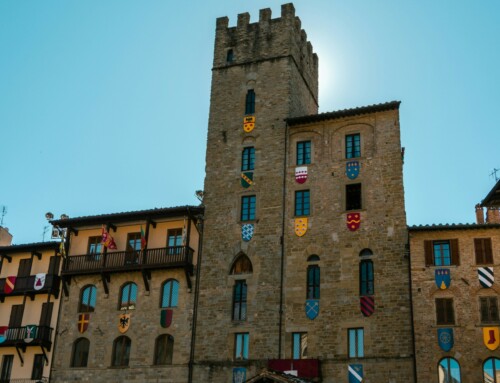Basilica of St. Francis in Arezzo: A Treasure for the City.

The Basilica of St. Francis in Arezzo, an emblematic place of history, art and spirituality, is known for its unfinished facade and the artistic treasure inside. Prominent among its works is the fresco cycle "The Story of the True Cross" by Piero della Francesca, located in the Bacci Chapel. Begun in 1290, the construction reflects the Romanesque architecture of the time, although the facade remained unfinished due to lack of funds. Despite periods of neglect and damage, the basilica has been restored and now shows its interiors enhanced, testifying to its cultural and historical importance for Arezzo and its visitors.
Discover the beauty of the Basilica of St. Francis with Poggio Del Drago!
The Basilica of St. Francis stands as a meeting point of history, art and spirituality in Arezzo.
Essential for those visiting Arezzo is the historic Basilica of San Francesco, positioned near the famous Petrarch Theater.
Externally, the church shows an unfinished facade, a project begun in the 14th century but never completed. This outward appearance, however, hides an extraordinary artistic wealth inside.
Inside, the Basilica holds a treasure trove of art and painting. Among the various works, the cycle “The Story of the True Cross” by Bicci di Lorenzo and mainly by Piero Della Francesca, created between 1452 and 1466, stands out. These frescoes decorate the “Bacci Chapel,” dedicated to the Bacci family of Arezzo, benefactors of the basilica and its works, located behind the high altar.
Near the famous cycle, partially preserved frescoes can be seen, the work of well-known 14th- and 15th-century Arezzo artists, including Spinello Aretino. Spinello’s works can also be seen in other significant places in Arezzo, such as the Basilica of San Domenico, and in the renowned Uffizi Gallery in Florence.
The Construction and Exterior of the Basilica
Construction of the Basilica of St. Francis began in 1290 at the behest of the followers of Francis of Assisi, on a pre-existing sacred site. Designed according to the architecture of the time with a single nave, it retains its Romanesque charm today, contrasting with the Gothic style of the Cathedral of Arezzo, located on the city’s highest hill.
The exterior facade remained unfinished due to lack of funds in the 14th century. In 1346, Monna Tessa donated 300 liras, insufficient to finish the work. A further construction attempt in 1870 was unsuccessful, damaging the structure. It was not until 1990, 45 years after it was proclaimed a Basilica, that the entrance was modernized, now bearing witness to its historic past and overlooking the square of the same name.
The Basilica of St. Francis: Periods of Abandonment and Rebirth
The Basilica has gone through periods of neglect and damage. Several frescoes, dating from the 14th-16th centuries, suffered damage. The structure was abandoned in 1556 due to a devastating fire. During the Napoleonic period and throughout the 19th century, the church lost its religious function, becoming a warehouse.
Restoration of the Basilica began in the 20th century with restorations aimed at safeguarding the frescoes. Umberto Tarlati, director of the works, despite his efforts, could not save many damaged works, but he managed to enhance the interior, which today houses important works of art. The last restoration, in 2020, involved the polychrome windows and the small columns of the Guasconi Chapel, which were compromised by structural problems.
Today the Basilica represents a renewed monument, the result of the careful care it has received over the centuries. The church, a true jewel of the city, deserves a visit that leaves visitors speechless, surprised by its beauty despite an austere exterior.




